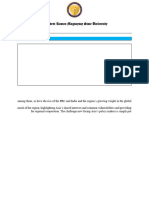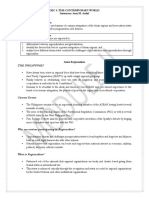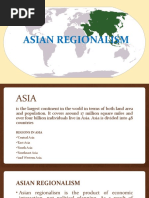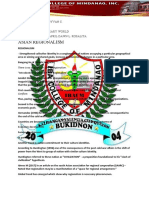CW Module 6
CW Module 6
Uploaded by
arln mndzCopyright:
Available Formats
CW Module 6
CW Module 6
Uploaded by
arln mndzOriginal Title
Copyright
Available Formats
Share this document
Did you find this document useful?
Is this content inappropriate?
Copyright:
Available Formats
CW Module 6
CW Module 6
Uploaded by
arln mndzCopyright:
Available Formats
Republic of the Philippines
President Ramon Magsaysay State University
The Contemporary World (GEC 3)
TOPIC VI – ASIAN REGIONALISM
Learning Objectives
After studying this topic, the student will be able to:
1. Identify the factors leading to a greater integration of the Asian region.
2. Analyze how different Asian states confront the challenges of globalization and
regionalization.
3. Define Asian Regionalism.
4. Identify or recognize the members of the ASEAN.
5. Tell the different functions of the ASEAN summit committee.
6. Examine critically the benefits of Asian Regionalism.
7. Differentiate realism from liberalism.
Asian regionalism is the product of economic interaction, not political planning. As a
result of successful, outward-oriented growth strategies, Asian economies have grown not only
richer, but also closer together. In recent years, new technological trends have further
strengthened ties among them, as have the rise of the PRC and India and the region’s growing
weight in the global economy. But adversity also played a role. The 1997/98 financial crisis dealt
a severe setback to much of the region, highlighting Asia’s shared interests and common
vulnerabilities and providing an impetus for regional cooperation. The challenge now facing
Asia’s policy makers is simply put yet incredibly complex: Where markets have led, how should
government follow?
Republic of the Philippines
President Ramon Magsaysay State University
The Contemporary World (GEC 3)
1|Page
FERDIE ORDONEZ BATARA | PRMSU – IBA CAMPUS
THE CONTEMPORARY WORLD (PEACE EDUCATION) / GEC 3
Asian Regionalism is the product of economic interaction, not political planning. ...
East Asian economies, in particular, focused on exporting to developed country markets rather
than selling to each other. Initially, they specialized in simple, labor-intensive manufactures.
Who is ASEAN?
Association of the South East Asian Nation
The Association of Southeast Asian Nations (ASEAN) is a 10-member regional bloc with a
combined GDP of $2.4 trillion, a population of 630 million, and a landmass covering more
than 1.7 million square miles.
Founded on August 1967 by
Indonesia, Malaysia, the Philippines, Singapore, and Thailand
Objective: To create a prosperous and peaceful community of South- East Asian Nations.
2|Page
FERDIE ORDONEZ BATARA | PRMSU – IBA CAMPUS
THE CONTEMPORARY WORLD (PEACE EDUCATION) / GEC 3
• Indonesia
• Malaysia
• Philippines
• Singapore
• Thailand
• Brunei
• Vietnam
• Laos
• Myanmar
• Cambodia
ASEAN seeks to
promote economic
growth and
regional stability
among its
members through
consultation, consensus, and cooperation based on the Treaty of Amity and Cooperation (TAC).
By combining the member states’ influence, ASEAN has been able to affect Asia Pacific
economic, political, and security trends to a much greater degree than its members could achieve
individually. ASEAN’s community building effort comprises three pillars: The Political-Security
Community; Economic Community; and Socio-Cultural Community.
As stated in the Treaty of Amity and Cooperation in Southeast Asia (TAC) of 1976. The ASEAN
Community functions under its six fundamental principles (ASEAN.org):
1. Mutual respect for the independence, sovereignty, equality, territorial integrity, and national
identity of all nations;
2. The right of every State led its national existence free from external interference, subversion or
coercion;
3. Non-interference in the internal affairs of one another;
4. Settlement of differences or disputes by peaceful manner;
5. Renunciation of the threat or use of force; and
6. Effective cooperation among themselves
3|Page
FERDIE ORDONEZ BATARA | PRMSU – IBA CAMPUS
THE CONTEMPORARY WORLD (PEACE EDUCATION) / GEC 3
AEM – ASEAN Economic Ministers
AMM – ASEAN Ministerial Meeting
AFMM – ASEAN Finance Ministers Meeting
SEOM – Senior Economic Officials Meeting
ASC – ASEAN Standing Committee
SOM – Senior Officials Meeting
ASC – ASEAN Standing Committee
SOM – Senior Officials Meeting
AFDM – ASEAN Finance and Central Bank Deputies Meeting
Supporting these ministerial bodies are 29 committees of senior officials and 122 technical
working groups.
End of Cold War
• ASEAN Free Trade Area
• initiated at ASEAN summit in 1992
• comprehensive program of regional tariff reduction
• program later broadened and accelerated
• reaffirmed during Asian Financial Crisis of 1997-98
• Expansion of ASEAN
• 1995: Vietnam
• 1997: Laos
• 1997: Myanmar
• 1999: Cambodia
ASEAN: external links
• A joint forum with Japan was established in 1977
• A cooperation agreement with the European Community was signed in 1980
• ``ASEAN + 3”: regular series of meetings at the cabinet and head-of-government levels
with Japan, China, and South Korea since 1997.
4|Page
FERDIE ORDONEZ BATARA | PRMSU – IBA CAMPUS
THE CONTEMPORARY WORLD (PEACE EDUCATION) / GEC 3
ASEAN and U.S.
• Investment:
– U.S. direct investment of US$157 billion in ASEAN
– nearly 3 times more than in China
– 10 times more than in India
• Trade:
– 4rd largest export market ($76 billion) for U.S.
– U.S. imported $123 billion from ASEAN
Northeast Asia
• Japan, South Korea, North Korea
• Mainland China, Hong Kong, Taiwan
• Mongolia, Russia
Northeast Asia
• Compared with Southeast Asia and West Europe, Northeast Asia has lagged behind
– in developing mechanisms or institutions
– of coordination, cooperation, or integration
• especially considering the immense economic potentials in the region
– natural resources
– human infrastructure
Political Difficulties
• Legacies of World War II
– Japanese atrocities in Pacific Asia
• Legacies of Cold War
– partition of Korea
• Territorial disputes between – Japan and China
– Japan and South Korea – Japan and Russia
– “Sea of Japan” or “East Sea”?
• mutually reinforcing suspicions
Current Status
• Washington-Tokyo-Beijing triangle
– PRC & Japan regard relationship with each other as 2nd in importance to that with
US
• Japan plays significant role in integrating PRC into world economy
• Japan has a vital interest in PRC’s development and stability
• Economic interdependence
• ASEAN Matters
How regionalism can benefit
5|Page
FERDIE ORDONEZ BATARA | PRMSU – IBA CAMPUS
THE CONTEMPORARY WORLD (PEACE EDUCATION) / GEC 3
• link the competitive strengths of its diverse economies in order to boost their productivity
and sustain the region’s exceptional growth;
• connect the region’s capital markets to enhance financial stability, reduce the cost of
capital, and improve opportunities for sharing risks;
• cooperate in setting exchange rate and macroeconomic policies in order to minimize the
effects of global and regional shocks and to facilitate the resolution of global imbalances;
• pool the region’s foreign exchange reserves to make more resources available for
investment and development;
• exercise leadership in global decision making to sustain the open global trade and
financial systems that have supported a half century of unparalleled economic
development;
• build connected infrastructure and collaborate on inclusive development to reduce
inequalities within and across economies and thus to strengthen support for pro-growth
policies
• Create regional mechanisms to manage cross-border health, safety, and environmental
issues better.
ASEAN Systems Theory
The strategic preferences of the Association of Southeast Asian Nations (ASEAN) members
should be a key variable in explaining the ASEAN integration process over the last four decades.
ASEAN integration will not progress as rapidly and substantially as many of its leaders claim
unless there are remarkable developments in factors that affect the underlying preferences of
ASEAN states, such as a significant increase in intra-ASEAN trade and investment a much
stronger pressure from domestic businesses for deeper integration, or external shocks that
threaten the region's economic growth. While the progressive path of European integration
illustrates that an independent and strong supranational institution is necessary to handle the
complex processes of regional integration, the strategic-preference theory of ASEAN integration
presented here
predicts that this will not be the top policy priority of its leaders in the near
future.
Regional Bandwagon
Approach: Realism vs Liberalism
Liberalism and realism are two of the most important theories in the field of International
Relations. They are different from one another in a number of ways.
Realism holds that all states pursue their interests while liberalism holds that states can cooperate
with one another and act more altruistically.
What are the main differences between Realism and Liberalism in the study of
International Relations? Realism
• holds that all states pursue their interests
• states want only to maintain their own security
• they want to get power so that they can be strong enough to be secure from attack
6|Page
FERDIE ORDONEZ BATARA | PRMSU – IBA CAMPUS
THE CONTEMPORARY WORLD (PEACE EDUCATION) / GEC 3
• international system can’t be manipulated to make peace
• international system is inherently anarchical and cannot really be made more peaceful
except through power
• don’t believe that democratization can bring peace
• believed that democratic countries will pursue power regardless of whether they are
democratic
• countries will fight if their interest dictate it, even if they and their opponents are both
democracies
• state only matters Liberalism
• holds that states can cooperate with one another and act more altruistically
• not always looking for power
• believed that the international system can be manipulated to make peace
• believed in things like United Nations which allow countries to interact with one another
in a variety of ways lead to less conflict between countries
• believed that democratization can bring peace
• believed that non-state actors are important
• pay attention to individual leaders
• pay attention to non-governmental organizations
SUMMARY
The Association of Southeast Asian Nations (ASEAN) was founded on August 1967 in
Bangkok, Thailand with Indonesia, Malaysia, Philippines, Singapore, and Thailand as its
founding fathers. Brunei Darussalam, Vietnam, Myanmar, and Cambodia joined the organization
making up today the 10 member-countries. The ASEAN Political-Security Community, ASEAN
Economic Community and ASEAN Socio-Cultural Community are three main pillars of
ASEAN.
The Association of Southeast Asian Nations (ASEAN) is a 10-member regional bloc with
a combined GDP of $2.4 trillion, a population of 630 million, and a landmass covering more than
1.7 million square miles.
ASEAN seeks to promote economic growth and regional stability among its members
through consultation, consensus, and cooperation based on the Treaty of Amity and Cooperation
(TAC). By combining the member states’ influence, ASEAN has been able to affect Asia Pacific
economic, political, and security trends to a much greater degree than its members could achieve
individually.
7|Page
FERDIE ORDONEZ BATARA | PRMSU – IBA CAMPUS
THE CONTEMPORARY WORLD (PEACE EDUCATION) / GEC 3
Republic of the Philippines
President Ramon Magsaysay State University
The Contemporary World
Quiz #4 (Midterm)
Name : Score : /55
Course, Year & Section : Date :
I. Identification.
1. It holds that states can cooperate with one another and act more
altruistically.
2. It is a large primary division of the world used in higher education —
originally in anthropology, but then also in geography and history, and as
the basis for area studies.
3. It holds that all states pursue their interests.
4. It is a term that has been emerging in transnational and postcolonial
studies to refer to what may also be called the "Third World", "developing
countries," "less developed countries," and "less developed regions."
5. It is a 10-member regional bloc with a combined GDP of $2.4 trillion, a
population of 630 million, and a landmass covering more than 1.7 million
square miles. Founded in 1967 by Indonesia, Malaysia, the Philippines,
Singapore, and Thailand.
6. This term arose during the Cold War to define countries that remained
non-aligned with either NATO or the Communist Bloc.
7. This region is made up of Africa, Latin America, and developing Asia
including the Middle East.
8. This region is home to all the members of the G8 and to four of the five
permanent members of the United Nations Security Council.
9. It is the product of economic interaction, not political planning. East Asian
economies, in particular, focused on exporting to developed country
markets rather than selling to each other. Initially, they specialized in
simple, labor-intensive manufactures.
10. Year when Vietnam joined the ASEAN.
II. Realism VS Liberalism. Write R for Realism and L for Liberalism.
1. holds that states can cooperate with one another and act more altruistically
2. not always looking for power
3. believed that the international system can be manipulated to make peace
4. believed in things like United Nations which allow countries to interact with one another in a
variety of ways lead to less conflict between countries
5. believed that democratization can bring peace
6. believed that non-state actors are important
7. pay attention to individual leaders
FERDIE ORDONEZ BATARA | PRMSU – IBA CAMPUS
THE CONTEMPORARY WORLD (PEACE EDUCATION) / GEC 3
8. pay attention to non-governmental organizations
9. holds that all states pursue their interests
10. states want only to maintain their own security
11. they want to get power so that they can be strong enough to be secure from attack
12. international system can’t be manipulated to make peace
10 | P a g e
13. international system is inherently anarchical and cannot really be made more peaceful except
through power
14. don’t believe that democratization can bring peace
15. believed that democratic countries will pursue power regardless of whether they are
democratic
16. countries will fight if their interest dictate it, even if they and their opponents are both
democracies
II. Acronyms.
1. AEM-
2. AMM-
3. AFMM-
4. SEOM-
5. ASC- 6.
SOM- 7.
ASC- 8.
AFDM- 9.
ASEAN-
III. Enumeration.
1-5. Term we used when we wish to discuss the collectivity of countries that constitutes the poor
world.
6-10. Founding members of
ASEAN. 11-20. Members of
the ASEAN.
FERDIE ORDONEZ BATARA | PRMSU – IBA CAMPUS
THE CONTEMPORARY WORLD (PEACE EDUCATION) / GEC 3
11 | P a g e
FERDIE ORDONEZ BATARA | PRMSU – IBA CAMPUS
THE CONTEMPORARY WORLD (PEACE EDUCATION) / GEC 3
You might also like
- Asian RegionalismDocument29 pagesAsian RegionalismLeslie Romero80% (5)
- Educational Reform EssayDocument7 pagesEducational Reform EssayLatoya WhartonNo ratings yet
- Immulogic Pharmaceutical CorporationDocument3 pagesImmulogic Pharmaceutical Corporationmiguel50% (2)
- TCW-Topic-VIDocument8 pagesTCW-Topic-VIcabubasshelaNo ratings yet
- Chaper-3.2-Asian-RegionalismDocument33 pagesChaper-3.2-Asian-RegionalismMaria TendenillaNo ratings yet
- The Contemporary World Module No. 2Document6 pagesThe Contemporary World Module No. 2Maryknoll NituraNo ratings yet
- New Week 9Document6 pagesNew Week 9Wendy Joy CuyuganNo ratings yet
- Asian RegionalismDocument51 pagesAsian RegionalismMarie ManzanoNo ratings yet
- Asian RegionalismDocument15 pagesAsian RegionalismLiezel AalaNo ratings yet
- Regional Is MDocument21 pagesRegional Is MnardnardNo ratings yet
- Asian RegionalismDocument3 pagesAsian RegionalismdapitananikaNo ratings yet
- Lesson 7 Asian RegionDocument6 pagesLesson 7 Asian Regionriza beltran100% (1)
- Unp-Dssp: Chapter 5: Asian RegionalismDocument9 pagesUnp-Dssp: Chapter 5: Asian RegionalismCatherine VenturaNo ratings yet
- World of RegionsDocument24 pagesWorld of RegionsSiena, John BenjieNo ratings yet
- Regional CooperationDocument17 pagesRegional Cooperationchandasai29No ratings yet
- Asian RegionalismDocument7 pagesAsian RegionalismCharlie BayabayaNo ratings yet
- Group 6 Asian RegionalismDocument15 pagesGroup 6 Asian RegionalismLaarni D. CaraniasNo ratings yet
- ASIAN-REGDocument27 pagesASIAN-REGMarjorie Pearl Maturan100% (1)
- What Is AseanDocument28 pagesWhat Is AseanFelix OffergeldNo ratings yet
- Asian RegionalismDocument33 pagesAsian Regionalismaljohn anticristoNo ratings yet
- Asian RegionalismDocument16 pagesAsian Regionalismerich.an2602No ratings yet
- World of RegionsDocument20 pagesWorld of RegionsDencio PrimaveraNo ratings yet
- Asian Regionalism-1Document29 pagesAsian Regionalism-1casillarericaashleyNo ratings yet
- Contemporary Week 6finalDocument5 pagesContemporary Week 6finalMary Joy BorjaNo ratings yet
- TCW Chapter 5Document41 pagesTCW Chapter 5Lucky Raia Joshuaine GutierrezNo ratings yet
- Module 8 Lesson ProperDocument4 pagesModule 8 Lesson ProperCêdriç ÇristobalNo ratings yet
- Banquirigan Group2 HANDOUTSDocument3 pagesBanquirigan Group2 HANDOUTSMay ComintanNo ratings yet
- Contemporary World Asian Regional Organizations 1. AseanDocument4 pagesContemporary World Asian Regional Organizations 1. AseanZarina Kate CondoyNo ratings yet
- Asian RegionalismDocument6 pagesAsian RegionalismDan CurateNo ratings yet
- GLOBALDocument25 pagesGLOBALJODETH NAVAJANo ratings yet
- Contemporary World - Association of South East Asian NationsDocument3 pagesContemporary World - Association of South East Asian NationsMicaela ContrerasNo ratings yet
- Asian RegionalismDocument17 pagesAsian RegionalismKurtny GarciaNo ratings yet
- ASEANDocument17 pagesASEANShubhada ChanfaneNo ratings yet
- Chapter 3-The Global Divides and Asian RegionalismDocument22 pagesChapter 3-The Global Divides and Asian RegionalismNicole Genzeinne Gumarao100% (1)
- STK Lessons ReviewDocument30 pagesSTK Lessons ReviewSethmonykeo MorbNo ratings yet
- Asian RegionalismDocument40 pagesAsian Regionalismgrade 11 c7No ratings yet
- 2nd Activity PATRIZDocument6 pages2nd Activity PATRIZAguilar PatrizNo ratings yet
- Layout 1 - OrangeDocument14 pagesLayout 1 - OrangeABCD EFGNo ratings yet
- Asian RegionalismDocument17 pagesAsian RegionalismpagalantecymeaNo ratings yet
- Asian Regionalism: Presented By: Christian Tactay Teejay Lance Pascua Victor Angelo Alejandro Bsa 2-ADocument43 pagesAsian Regionalism: Presented By: Christian Tactay Teejay Lance Pascua Victor Angelo Alejandro Bsa 2-AVictor Angelo AlejandroNo ratings yet
- Asian Regionalism: Presented By: Group 4Document34 pagesAsian Regionalism: Presented By: Group 4Abdulla MacarayaNo ratings yet
- THE Contemporary World: Module #5Document12 pagesTHE Contemporary World: Module #5Brian DuelaNo ratings yet
- Chapter 5 ASIAN REGIONALISMDocument33 pagesChapter 5 ASIAN REGIONALISMLorenzo Saplan100% (2)
- World of Regions: Lesson 5Document6 pagesWorld of Regions: Lesson 5Jocel Sangalang0% (1)
- Asian RegionalismDocument40 pagesAsian RegionalismWinnie AriolaNo ratings yet
- Unit 5 - Regional Integration, EU, and ASEAN: Asian Regional Organizations (From Reference Book)Document2 pagesUnit 5 - Regional Integration, EU, and ASEAN: Asian Regional Organizations (From Reference Book)KENT BENEDICT PERALESNo ratings yet
- What Is ASEAN?Document6 pagesWhat Is ASEAN?AnushkaNo ratings yet
- Group 2 Hardcopy of The Report Maam AprilDocument4 pagesGroup 2 Hardcopy of The Report Maam AprilRoyvan AlimaongNo ratings yet
- ASEANDocument24 pagesASEANshetani151No ratings yet
- Asian Regionalism 2Document17 pagesAsian Regionalism 2aljon jayNo ratings yet
- Chapter V Asian RegionalismDocument40 pagesChapter V Asian RegionalismJessica Mae GalvanNo ratings yet
- LESSON 5 NotesDocument4 pagesLESSON 5 Notesg.balboa.547700No ratings yet
- Asian RegionalismDocument3 pagesAsian RegionalismM GanelaNo ratings yet
- Contemporary Reportgroup 4 (1)Document30 pagesContemporary Reportgroup 4 (1)batiaojoyceNo ratings yet
- 5.-Asian-RegionalismDocument41 pages5.-Asian-Regionalismmariachona.plenosNo ratings yet
- Asian RegionalismDocument4 pagesAsian RegionalismIsabel ParcoNo ratings yet
- Asian Regionalism: A Style of Its OwnDocument21 pagesAsian Regionalism: A Style of Its OwnNaitsirhc NaitsirhcNo ratings yet
- Asian RegionalismDocument5 pagesAsian RegionalismHeyy ItshexsuuNo ratings yet
- Global DividesDocument14 pagesGlobal DividesReeze Vreena TamarayNo ratings yet
- Asian Regionalism 1st Presentation Group 1Document20 pagesAsian Regionalism 1st Presentation Group 1aizeeguiling19No ratings yet
- Chapter 1 HandoutDocument5 pagesChapter 1 Handoutmonicapines3No ratings yet
- Gale Researcher Guide for: Rivalry in Asia-Pacific Regions: APEC and ASEANFrom EverandGale Researcher Guide for: Rivalry in Asia-Pacific Regions: APEC and ASEANNo ratings yet
- Q3 RWS TosDocument2 pagesQ3 RWS Tosarln mndzNo ratings yet
- Reviewer Sa FinalDocument93 pagesReviewer Sa Finalarln mndzNo ratings yet
- Human Behavior and Decision Making Concepts of IPMDocument7 pagesHuman Behavior and Decision Making Concepts of IPMarln mndz100% (2)
- Module 3 Deciding To Raise PoultryDocument15 pagesModule 3 Deciding To Raise Poultryarln mndzNo ratings yet
- Art Appreciation Module 14Document11 pagesArt Appreciation Module 14arln mndzNo ratings yet
- CW Module 7Document15 pagesCW Module 7arln mndzNo ratings yet
- CW Module 1Document17 pagesCW Module 1arln mndzNo ratings yet
- Design Guide For Implementing Warm HandoffsDocument12 pagesDesign Guide For Implementing Warm HandoffsTerrence ItalioNo ratings yet
- Billy D. Rosalinas: ObjectiveDocument2 pagesBilly D. Rosalinas: ObjectiveCANDEVCO DaetNo ratings yet
- 50 Articulos de RevisionDocument277 pages50 Articulos de RevisionDaniel Christian Ruiz TorrezNo ratings yet
- B1+ - Extra Vocabulary and Grammar Activities - Unit 2Document1 pageB1+ - Extra Vocabulary and Grammar Activities - Unit 2idoiamcn100% (1)
- Attempt Any Part Questions.: Note TwentyDocument2 pagesAttempt Any Part Questions.: Note TwentyOwais MalikNo ratings yet
- مجلة جهاز التنفس الاصطناعيDocument3 pagesمجلة جهاز التنفس الاصطناعيمحمد الاشولNo ratings yet
- 4 P's of MarketingDocument4 pages4 P's of MarketingSunil PillaiNo ratings yet
- Muhammad Rizaldy Putra F23117114Document2 pagesMuhammad Rizaldy Putra F23117114Rizaldy PutraNo ratings yet
- Digital IndiaDocument4 pagesDigital Indiaviveksharma51No ratings yet
- Dissertation Topics in EntrepreneurshipDocument4 pagesDissertation Topics in EntrepreneurshipWhitePaperWritingServicesSingapore100% (2)
- Collar Bolts in Shell and Tube Heat ExchangersDocument3 pagesCollar Bolts in Shell and Tube Heat ExchangersBaher ElsheikhNo ratings yet
- Fundamental Steps in Digital Image ProcessingDocument2 pagesFundamental Steps in Digital Image ProcessingDebansu AndrEs Bhattacharya100% (2)
- Physics AnsDocument14 pagesPhysics AnsAditya Narayan SahooNo ratings yet
- Subsea High Voltage Power DistributionDocument9 pagesSubsea High Voltage Power DistributionSeun Sam AdetolaNo ratings yet
- Third Quarter: Force, Motion, AND EnergyDocument10 pagesThird Quarter: Force, Motion, AND EnergyCABALIDA, FELICITY H.No ratings yet
- Method of CharacteristicsDocument11 pagesMethod of CharacteristicsIshik AraNo ratings yet
- Roll Number SlipDocument1 pageRoll Number SlipArslan DurraniNo ratings yet
- XII English NotesDocument15 pagesXII English NotesAnushka SinghNo ratings yet
- Nyse Levi 2020Document22 pagesNyse Levi 2020Karina PoghosyanNo ratings yet
- Meu Ams-C1Document29 pagesMeu Ams-C1AdityaGedeNo ratings yet
- Biomedical Engineering TechnologyDocument36 pagesBiomedical Engineering TechnologyAbhilash Chandran JNo ratings yet
- WIng Configurations2Document53 pagesWIng Configurations2Francisco Zurisaddai MenesesNo ratings yet
- Q1 W3-4 MIL Responsible Use of Media and InformationDocument6 pagesQ1 W3-4 MIL Responsible Use of Media and InformationJunrey Belando50% (2)
- Instant Ebooks Textbook Vagueness in Psychiatry First Edition Hauswald Download All ChaptersDocument62 pagesInstant Ebooks Textbook Vagueness in Psychiatry First Edition Hauswald Download All Chapterssudebmeucci75100% (4)
- Quality Assurance Plan of Belt Feeder & Belt Weigh FeederDocument2 pagesQuality Assurance Plan of Belt Feeder & Belt Weigh FeederMohammad AdilNo ratings yet
- Como Calcular Fuerzas de Arrastre en OpenFoamDocument5 pagesComo Calcular Fuerzas de Arrastre en OpenFoamHugo ContrerasNo ratings yet
- Fib Assignment SolutionsDocument15 pagesFib Assignment SolutionsMusangabu EarnestNo ratings yet
- Encyclopedia of Computer Science and Technology, Second - Laplante, Phillip A - Second Edition, 2017 - CRC Press - 9781351645515 - Anna's ArchiveDocument503 pagesEncyclopedia of Computer Science and Technology, Second - Laplante, Phillip A - Second Edition, 2017 - CRC Press - 9781351645515 - Anna's Archiveyonamas33No ratings yet
































































































